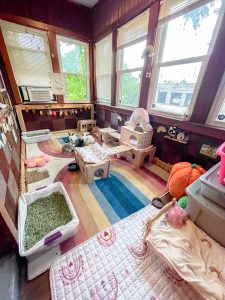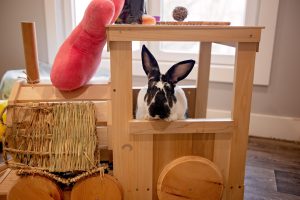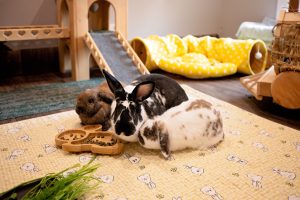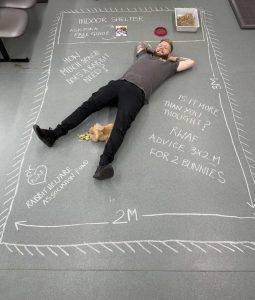Rabbits are charming, intelligent companions who bring joy and warmth to our homes and should be given the same respect as cats and dogs. As responsible rabbit guardians, it is our duty to provide them with an environment that promotes both physical and mental well-being. We at HRS Chicago believe rabbits in North America are safest and happiest as indoor companions.
Understanding the Basics:
Indoor rabbit housing involves creating a space that mimics a rabbit’s natural habitat, allowing them to exhibit their natural behaviors. For folks who can’t let their rabbits free roam or live in a dedicated bunny room, creating a designated area with 2-3 exercise pens can be a good option. Rabbits should have the freedom to do zoomies and binkies at all times of the day, especially overnight when they are most active. Along with other rabbit welfare organizations, we are moving away from using single 4×4 pens for any length of time. This is not sufficient space for any rabbit. Keeping rabbits confined to a small pen can cause mental health problems like boredom and aggression. Being unable to run around freely leads to health issues such as arthritis, spondylosis, bladder sludge, and muscle wasting.
Space Requirements:
The Rabbit Welfare Association & Fund emphasizes the importance of providing sufficient space for rabbits to live comfortably. Their guidelines suggest a minimum of 10ft x 6ft of space for a pair of small to average sized rabbits. Larger breeds or more active rabbits will require even more space. This ensures that they have enough room to hop, run, stand on their hind legs, and stretch out – vital activities for their physical health and mental stimulation. Generally 30 inches is plenty of height to contain most rabbits in an indoor space, but occasionally you’ll need to invest in much taller pens for adventurous jumpers or climbers. Never ever lock a rabbit in a cage or a hutch for any length of time. Cages can be used as litter boxes if left open at all times but they can also cause territorial issues with bonded bunnies if they are enclosed. A hutch that’s left open 24/7 can be used as a hiding spot but keep in mind they can be very difficult to clean.
Creating a Stimulating Environment:
Rabbits are intelligent and curious creatures who still have most of their wild instincts and a well-designed indoor space can provide endless opportunities for mental stimulation. Incorporating tunnels, hides, dig boxes and a variety of toys can keep your rabbit engaged and prevent boredom. We suggest the use of cardboard boxes with entrances and exits as a way to mimic the burrows that rabbits would create in the wild. Rabbits also love to zoom through cat tunnels.
Additionally, providing platforms or ramps can add vertical space to the enclosure, allowing rabbits to explore and exercise their natural instinct to survey their surroundings. We cannot emphasize enough the importance of hiding places within the enclosure, as rabbits are prey animals and often feel safer when they have a secure space to retreat to.
Dig boxes can include shredded/crumpled paper or plastic balls. We do not recommend using sand in dig boxes as it can cause digestive upset if too much is ingested.
Baby stacking cups, plastic baby keys, wooden chews and puzzle toys are all great for providing mental stimulation and can prevent your rabbits from getting bored.
Location Matters:
Selecting an appropriate location for your rabbit’s indoor haven is crucial. We recommend choosing a quiet area away from excessive noise, any predatory pets, direct sunlight, and drafts. Rabbits are sensitive to their environment, and a peaceful location will help them feel secure and at ease.
Maintenance and Cleaning:
Maintaining a clean and hygienic living space is essential for the health of your rabbit. Regular spot cleaning and a thorough cleaning routine, including changing bedding and washing litter boxes, are vital aspects of rabbit care. Plain vinegar is a safe and effective cleaner for your rabbit’s space. If you’re not using litter box liners, it easily dissolves the calcium buildup in litter boxes as well.
Creating the perfect indoor housing for your rabbit involves thoughtful planning, incorporating elements to encourage their natural behaviors, and providing ample space for them to thrive. By following these basic guidelines, you can ensure that your rabbit not only survives but thrives in their indoor home. A happy and healthy rabbit is a joyous companion, and the effort you invest in their living space will be rewarded with years of happy and healthy bunnies!

The Belden Buns


Agi Zeman’s trio

RWAF’s Space Recommendation
